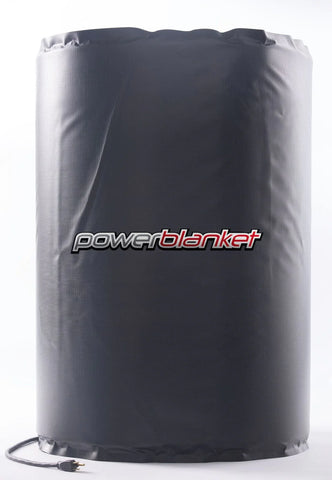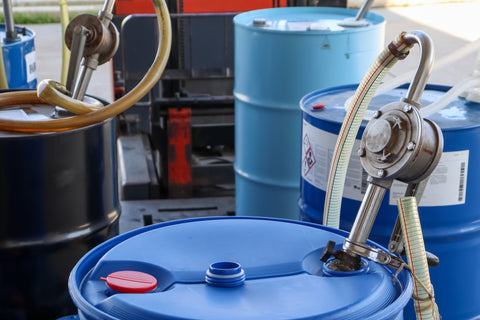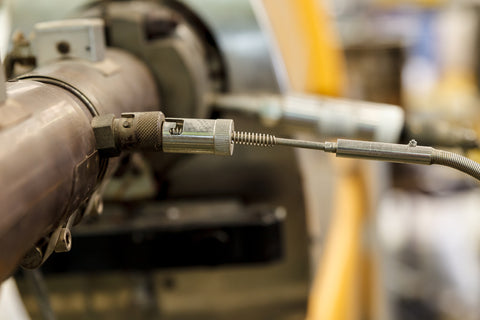Navigating Temperature Challenges in Industrial Storage: An Introduction to Temperature Extremes for Drums & Barrels
The resilience of 55-gallon drums to temperature extremes is a critical factor in many industries. These drums are often exposed to harsh conditions, ranging from the freezing temperatures of outdoor storage in northern climates to the scorching heat of industrial processes in manufacturing plants.
The ability of drum heaters and insulating solutions to maintain a stable temperature amidst these extremes is vital. For instance, in the chemical industry, certain compounds must be kept within a specific temperature range to prevent degradation or hazardous reactions. Similarly, in the food industry, oils and liquid ingredients stored in drums require precise temperature control to preserve their quality and prevent spoilage. The introduction to the temperature regulating 55-gallon drum heaters has been a game-changing introduction to industries that require viscosity control and awareness of temperature-sensitive materials.
High-Temperature Endurance and Applications
High-temperature endurance is a key attribute of 55-gallon drums, especially those made of metal and steel. These drums can withstand temperatures significantly higher than their plastic counterparts, making them ideal for use in industries like metalworking, where they might be exposed to extreme heat.
Using a drum heater in such environments is crucial for maintaining temperature control. For instance, in the asphalt industry, maintaining high temperatures is essential for keeping the material in a liquid state for road construction. Similarly, in the pharmaceutical industry, certain drugs or compounds require storage at elevated temperatures to sustain their efficacy. A drum heater can enable consistent heat, eliminating hot and cold spots that can prevent a 55-gallon drum of various materials from maintaining proper viscosity.
Low-Temperature Challenges and Solutions
Conversely, low-temperature challenges are predominant in regions with harsh winters or in industries where materials must be kept cool. In such cases, drums must be equipped with heating solutions that can prevent the contents from freezing. This is particularly important for materials like paints or industrial lubricants, which can lose their properties or become unusable if allowed to freeze. The use of insulated drum blankets and heaters with freeze protection features becomes crucial in these scenarios. In the agricultural sector, for example, storing liquid fertilizers at a stable temperature is essential to prevent crystallization and ensure their effectiveness.
Industry-Specific Uses and Adaptations
Different industries have adapted the use of 55-gallon drums to suit their unique temperature challenges. In the brewing industry, maintaining a consistent temperature is crucial during the fermentation process, and specialized drum heaters are used to achieve this. In the energy sector, particularly in oil and gas, the temperature of substances like crude oil must be carefully controlled to ensure safe handling and effective processing.
Industries that Require High Temperatures
-
Metalworking Industry:
-
Temperature Range: Often requires maintaining temperatures up to 400°F (204°C).
-
Applications: Ideal for storing and processing molten metals and high-temperature lubricants.
-
-
Asphalt Industry:
-
Temperature Range: Asphalt must be kept between 275°F to 350°F (135°C to 177°C).
-
Applications: Essential for maintaining asphalt in a liquid state for road construction and patching.
-
-
Pharmaceutical Industry:
-
Temperature Range: Certain drugs require storage at temperatures ranging from 150°F to 250°F (65°C to 121°C).
-
Applications: Used for storing heat-sensitive drugs and organic compounds to preserve their efficacy.
-

Industries that Require Low Temperatures
-
Paint and Coating Industry:
-
Temperature Range: Must prevent freezing, typically at temperatures below 32°F (0°C).
-
Applications: Necessary for storing water-based paints and coatings to prevent freezing and separation.
-
-
Industrial Lubricants:
-
Temperature Range: Need to be kept above their cloud point, usually above 40°F (4°C).
-
Applications: Important for maintaining the fluidity and effectiveness of lubricants in cold environments.
-
-
Agricultural Sector:
-
Temperature Range: Liquid fertilizers need to be kept above 32°F (0°C) to prevent crystallization.
-
Applications: Essential for the storage of liquid fertilizers and pesticides to ensure their effectiveness and ease of application.
-

Advanced Temperature Management Solutions for 55 Gallon Drums
In the realm of industrial storage and processing, the need for advanced temperature management is paramount, especially when dealing with 55-gallon drums. This section delves into various solutions, emphasizing drum heaters, drum heating blankets, and other heating solutions tailored to meet the specific needs of temperature-sensitive materials and processes.
The Role of Drum Heaters in Precise Temperature Control
-
Importance of Drum Heaters:
-
Drum heaters are essential for maintaining a stable temperature within 55-gallon drums. They are particularly crucial in industries where precise temperature control is necessary for maintaining the quality and integrity of products.
-
Temperature ranges: Drum heaters are versatile, able to maintain temperatures from just above freezing to several hundred degrees Fahrenheit, depending on the product requirements.
-
-
Types of Drum Heaters:
-
Drum heating blankets offer a flexible and efficient way to wrap around the drum, providing consistent heat and preventing hot and cold spots (2–6 mentions).
-
Barrel heaters are another popular option, known for their ability to deliver high heat output, essential for materials requiring higher temperatures.
-

Managing Viscosity and Protecting Sensitive Materials
-
Viscosity Control:
-
Many liquids stored in metal drums have specific viscosity requirements. Maintaining the right temperature is crucial to keep these liquids at their optimal viscosity, ensuring smooth flow and processing.
-
-
Handling Temperature Sensitive Materials:
-
For temperature-sensitive products (1 mention), such as certain chemicals or foodstuffs, drum heaters, and drum heating blankets, ensure that these materials are stored at the correct temperature, preventing spoilage or degradation.
-
Innovative Features in Drum Heating Solutions
-
Fixed Internal Thermostat:
-
A modern 55-gallon drum heater will most likely come with a fixed internal thermostat, providing automatic temperature control. This feature ensures that the temperature inside the drum remains consistent, eliminating the risk of overheating or underheating.
-
-
Adjustable Thermostat
-
Other advanced drum heaters have an adjustable thermostat, offering flexible temperature control to suit various industrial needs. This feature allows users to manually set and adjust the temperature as required, accommodating a wide range of materials and processes. The adjustable thermostat is particularly beneficial in scenarios where different products within the same drum require varying temperature settings, providing the versatility needed for precise and efficient temperature management.
-
-
Efficiency and Safety:
-
Drum heaters and blankets are designed to distribute heat evenly, reducing energy consumption and enhancing safety. They are particularly useful in cold temperatures, where the risk of materials freezing or thickening is high.
-
The Importance of Selecting the Right Heating Solution
Selecting the right heating solution – whether a drum heater, drum heating blanket, drum blanket, or barrel heater – is vital for efficient and safe operations in industries where temperature regulation is critical. Understanding the specific needs of the stored materials, such as viscosity requirements or sensitivity to temperature fluctuations, will guide the choice of the most appropriate and effective temperature management system.
Advancements in Drum Heater Technology
The technology behind drum heating has evolved significantly. Modern drum heaters are equipped with advanced features like digital thermostats for precise temperature control and automated systems that adjust the heat intensity based on the external temperature. These advancements ensure that the contents of the drum are kept at an optimal temperature, regardless of the surrounding environment.
Safety Standards and Compliance
Safety is paramount when dealing with extreme temperatures. Drum heaters and insulating solutions are designed to meet rigorous safety standards. Compliance with certifications like ETL and adherence to CSA and CE safety standards ensure that these products are safe for use in various industrial environments. This is especially critical in industries where the risk of fire or chemical reactions is high.
ETL Certification:
-
Meaning: ETL certification indicates that a product has been tested and meets the minimum safety standards established by the Occupational Safety and Health Administration (OSHA) in the United States.
-
Significance: Products with ETL certification have undergone rigorous testing for safety and performance, ensuring they are safe for industrial use and meet the necessary legal requirements.
-
CSA Safety Standards:
-
Meaning: CSA refers to the Canadian Standards Association, which sets safety and performance standards for products used in Canada.
-
Significance: Products adhering to CSA safety standards have been tested to ensure they meet high safety and performance standards, providing assurance of reliability and safety in demanding industrial environments.
CE Safety Standards:
-
Meaning: CE marking signifies that a product complies with the European Union's health, safety, and environmental protection regulations.
-
Significance: The CE mark is essential for products sold in the European Economic Area (EEA), indicating that they meet EU safety, health, and environmental requirements and are safe for use in European workplaces.
Importance of Compliance:
-
Risk Mitigation: Compliance with these safety standards is critical in mitigating risks like fire hazards, chemical spills, or accidents due to equipment failure, especially in industries that operate under extreme temperatures.
-
Industry Trust: Adhering to these recognized safety standards helps build trust among users and industry regulators, demonstrating a commitment to safety and quality.
Environmental Considerations
Environmental considerations also play a role in the design and use of temperature-regulating solutions for 55-gallon drums. Energy-efficient heaters and insulating blankets not only save costs but also reduce the carbon footprint of industrial operations. The use of eco-friendly materials in the construction of these solutions is also a growing trend, reflecting the industry's commitment to sustainability.
Future Trends and Innovations
Looking to the future, the industry is poised for further innovations in drum temperature control. Developments such as solar-powered drum heaters and smart, IoT-enabled temperature monitoring systems are on the horizon. These advancements promise to make temperature control more efficient, safe, and environmentally friendly.
Drum Temperature Control FAQs
What is the temperature of a drum heater?
Drum heaters can typically reach temperatures ranging from 32 to 320 or more degrees, depending on the model and the application for which it is used.
How hot do barrel heaters get? How hot do drum heaters get?
Barrel heaters can get quite hot, with some models capable of reaching temperatures up to 450°F (232°C).
Do drum heaters work? Does a drum heater work?
Yes, drum heaters are effective in maintaining or raising the temperature of the contents inside the drum, ensuring they remain at the optimal temperature for use or storage.
At what pressure does a 55-gallon drum burst?
A 55-gallon drum can burst at pressures around 14.7 psi (pounds per square inch), but this can vary depending on the drum's material, construction, and condition.
Embracing the Future of Temperature Management in Industry: Concluding Thoughts on 55-Gallon Drums
In conclusion, managing high and low temperatures in 55-gallon drums is a complex task that requires a deep understanding of the materials being stored and the environmental conditions they are exposed to. From high-temperature applications in metalworking to low-temperature challenges in cold climates, the right heating solution is crucial for the safe, effective, and efficient operation of various industries. As technology advances, we can expect even more innovative and environmentally friendly solutions to emerge in this field.







